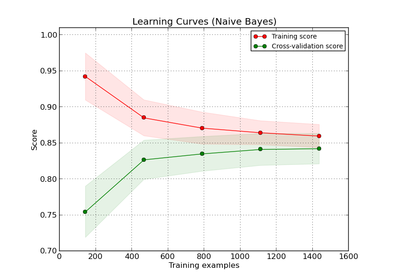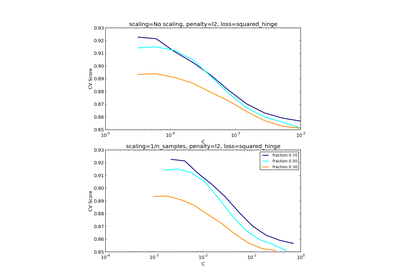sklearn.model_selection.ShuffleSplit¶
- class sklearn.model_selection.ShuffleSplit(n_iter=10, test_size=0.1, train_size=None, random_state=None)[source]¶
Random permutation cross-validator
Yields indices to split data into training and test sets.
Note: contrary to other cross-validation strategies, random splits do not guarantee that all folds will be different, although this is still very likely for sizeable datasets.
Read more in the User Guide.
Parameters: n_iter : int (default 10)
Number of re-shuffling & splitting iterations.
test_size : float, int, or None, default 0.1
If float, should be between 0.0 and 1.0 and represent the proportion of the dataset to include in the test split. If int, represents the absolute number of test samples. If None, the value is automatically set to the complement of the train size.
train_size : float, int, or None (default is None)
If float, should be between 0.0 and 1.0 and represent the proportion of the dataset to include in the train split. If int, represents the absolute number of train samples. If None, the value is automatically set to the complement of the test size.
random_state : int or RandomState
Pseudo-random number generator state used for random sampling.
Examples
>>> from sklearn.model_selection import ShuffleSplit >>> X = np.array([[1, 2], [3, 4], [5, 6], [7, 8]]) >>> y = np.array([1, 2, 1, 2]) >>> rs = ShuffleSplit(n_iter=3, test_size=.25, random_state=0) >>> rs.get_n_splits(X) 3 >>> print(rs) ShuffleSplit(n_iter=3, random_state=0, test_size=0.25, train_size=None) >>> for train_index, test_index in rs.split(X): ... print("TRAIN:", train_index, "TEST:", test_index) ... TRAIN: [3 1 0] TEST: [2] TRAIN: [2 1 3] TEST: [0] TRAIN: [0 2 1] TEST: [3] >>> rs = ShuffleSplit(n_iter=3, train_size=0.5, test_size=.25, ... random_state=0) >>> for train_index, test_index in rs.split(X): ... print("TRAIN:", train_index, "TEST:", test_index) ... TRAIN: [3 1] TEST: [2] TRAIN: [2 1] TEST: [0] TRAIN: [0 2] TEST: [3]
Methods
get_n_splits([X, y, labels]) Returns the number of splitting iterations in the cross-validator split(X[, y, labels]) Generate indices to split data into training and test set. - get_n_splits(X=None, y=None, labels=None)[source]¶
Returns the number of splitting iterations in the cross-validator
Parameters: X : object
Always ignored, exists for compatibility.
y : object
Always ignored, exists for compatibility.
labels : object
Always ignored, exists for compatibility.
Returns: n_splits : int
Returns the number of splitting iterations in the cross-validator.
- split(X, y=None, labels=None)[source]¶
Generate indices to split data into training and test set.
Parameters: X : array-like, shape (n_samples, n_features)
Training data, where n_samples is the number of samples and n_features is the number of features.
y : array-like, shape (n_samples,)
The target variable for supervised learning problems.
labels : array-like, with shape (n_samples,), optional
Group labels for the samples used while splitting the dataset into train/test set.
Returns: train : ndarray
The training set indices for that split.
test : ndarray
The testing set indices for that split.



